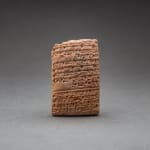Sumerian Cuneiform Tablet, 2033 BCE
Clay
1.81 x 2.91
CT.031
Sumerian cuneiform is one of the earliest known forms of written expression. First appearing in the 4th millennium BC in what is now Iraq, it was dubbed cuneiform (‘wedge-shaped’) because...
Sumerian cuneiform is one of the earliest known forms of written expression. First appearing in the 4th millennium BC in what is now Iraq, it was dubbed cuneiform (‘wedge-shaped’) because of the distinctive wedge form of the letters, created by pressing a reed stylus into wet clay. Early Sumerian writings were essentially pictograms, which became simplified in the early and mid 3rd millennium BC to a series of strokes, along with a commensurate reduction in the number of discrete used (from c.1500 to 600). The script system had a very long life and was used by the Sumerians as well as numerous later groups – notably the Assyrians, Elamites, Akkadians and Hittites – for around three thousand years. Certain signs and phonetic standards live on in modern languages of Middle and Far East, but the writing system is essentially extinct. It was therefore cause for great excitement when the ‘code’ of ancient cuneiform was cracked by a group of English, French and German Assyriologists and philologists in the mid 19th century AD. This opened up a vital source of information about these ancient groups that could not have been obtained in any other way.
Cuneiform was used on monuments dedicated to heroic – and usually royal – individuals, but perhaps its most important function was that of record keeping. The palace-based society at Ur and other large urban centres was accompanied by a remarkably complex and multifaceted bureaucracy, which was run by professional administrators and a priestly class, all of whom were answerable to central control. Most of what we know about the way the culture was run and administered comes from the cuneiform tablets, which record the everyday running of the temple and palaces complexes in minute detail, as in the present case. The Barakat Gallery has secured the services of Professor Lambert (University of Birmingham), a renowned expert in the decipherment and translation of cuneiform, to examine and process the information on these tablets. The following is a transcription of his analysis of this tablet:
Clay Tablet, with 23 lines of Sumerian Cuneiform on obverse and reverse. A little loss at the bottom edge and the obverse has some surface loss, but much of the text can be read and understood. It is an administrative document from the period of the Third Dynasty of Ur, dated to the 5th year of Shu-Sin, fouth king of the dynasty, c. 2033 B.C. It lists rations paid oout to official messengers to sustain them on their trips.
Translation:
2 sila of soup, 2 fish: Shu-Mamma, vizier, king’s messenger when he went to Isin (?)
2 sila of soup, 2 fish Puzur-Sin, king’s messenger when he went to bring out the ……
1 sila of soup, 1 fish: …….., king’s messnger (when) he went (…………)
(1 aila of soup, 1) fish: ……da, king’s messenger.
1 sila of soup, 1 fish: Ur-Ninazu, king’s messenger when they went to Der.
i sila of soup, 1 fish: Anum-dan, king’s messenger when he went to Hurtum.
Disbursement for the month Ezen-abi.
Year after: Shu-Sin, king of Ur built the west wall “that which keeps the Tidnum at bay”.
A sila was a measure of capacity, about .85 of a litre. It’s use with soup is obvious, but the fish were simply counted. No doubt there were standard size fish for this purpose, and they could have been fresh or dried.
Cuneiform was used on monuments dedicated to heroic – and usually royal – individuals, but perhaps its most important function was that of record keeping. The palace-based society at Ur and other large urban centres was accompanied by a remarkably complex and multifaceted bureaucracy, which was run by professional administrators and a priestly class, all of whom were answerable to central control. Most of what we know about the way the culture was run and administered comes from the cuneiform tablets, which record the everyday running of the temple and palaces complexes in minute detail, as in the present case. The Barakat Gallery has secured the services of Professor Lambert (University of Birmingham), a renowned expert in the decipherment and translation of cuneiform, to examine and process the information on these tablets. The following is a transcription of his analysis of this tablet:
Clay Tablet, with 23 lines of Sumerian Cuneiform on obverse and reverse. A little loss at the bottom edge and the obverse has some surface loss, but much of the text can be read and understood. It is an administrative document from the period of the Third Dynasty of Ur, dated to the 5th year of Shu-Sin, fouth king of the dynasty, c. 2033 B.C. It lists rations paid oout to official messengers to sustain them on their trips.
Translation:
2 sila of soup, 2 fish: Shu-Mamma, vizier, king’s messenger when he went to Isin (?)
2 sila of soup, 2 fish Puzur-Sin, king’s messenger when he went to bring out the ……
1 sila of soup, 1 fish: …….., king’s messnger (when) he went (…………)
(1 aila of soup, 1) fish: ……da, king’s messenger.
1 sila of soup, 1 fish: Ur-Ninazu, king’s messenger when they went to Der.
i sila of soup, 1 fish: Anum-dan, king’s messenger when he went to Hurtum.
Disbursement for the month Ezen-abi.
Year after: Shu-Sin, king of Ur built the west wall “that which keeps the Tidnum at bay”.
A sila was a measure of capacity, about .85 of a litre. It’s use with soup is obvious, but the fish were simply counted. No doubt there were standard size fish for this purpose, and they could have been fresh or dried.



